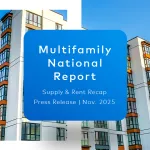The U.S. asking rent gained $2 to $1,729, for a 1.6% YoY rise in July, but a rotation in the rankings of rent growth on a metro level took place.
Report highlights:
- Asking rents rose 1.6% year-over-year through July, with Midwest and Northeast metros regaining top positions.
- Demand for rentals was sustained by the healthy job market and conditioned by supply growth.
- Renter-by-Necessity rents rose 0.2% month-over-month in July, while Lifestyle rents remained flat. Occupancy still at 95.0%.
- Single-family rents rose 1.2% year-over-year in July to $2,108
Rents continue tepid growth
The average U.S. multifamily asking rent rose 1.6% year-over-year in July, gaining $2 to $1,729. The rate was 30 basis points below June, marking an overall 400-basis-point drop from the beginning of the year. On a metro level, rent growth continued to rotate, with Sun Belt markets cooling down, replaced by Midwest and Northeast metros. Seven of the top eight metros are in these regions, led by Indianapolis and New York (5.5% each), New Jersey (5.4%) and Chicago (5.2%). The largest rent contractions were recorded in Las Vegas (-3.5%), Phoenix (-3.1%) and Austin (-2.8%).
The market rotation is attributed for the most part to affordability, slowing domestic migration and supply growth. Of Yardi Matrix’s top 30 markets, 12 had supply growth of 2.5% or more year-over-year, and six of these posted negative rent growth in July. Leaders in supply growth were Austin (4.4%), Nashville (4.1%) and Raleigh (3.5%). Indianapolis and New York, leaders in rent growth, were among the metros with the lowest stock expansions (0.7% each).
The employment market remained robust, adding 1.7 million jobs in the first half of 2023. This has kept consumer balance sheets strong and sustained apartment demand. Through the end of May, absorption totaled 120,000 units nationwide, in line with historical norms. Moreover, the national occupancy rate decreased 0.8% year-over-year, but remained flat at 95.0%. The rate declined in across Yardi Matrix’s top 30 metros except in Chicago (up 0.2%) and New York (0.1%). In 11 of Matrix’s top 30 metros the rate dropped by 1.0% or more.
RBN segment keeps rent growth positive
On a monthly basis, rents rose 0.1% in July, with Philadelphia in the lead (up 0.9%), followed by Chicago (0.7%), Tampa (0.6%), Denver (0.5%) and San Diego (0.5%). Short-term rent growth was sustained by the RBN segment, up 0.2%, while Lifestyle rents remained flat. RBN rents increased in 19 of the top 30 Matrix metros, while Lifestyle rents rose in 13. This imbalance is in part due to the new deliveries, nearly all in the upscale segment. More so, Lifestyle rents contracted by 1.0% or more month-over-month in July in Orlando (-1.0%), Columbus (-1.1%) and Detroit (-1.8%), and rose by 1.0% or more just in Tampa (1.0%).
Renewal rent growth rose 8.1% year-over-year nationally in May, and while it’s down from the 8.5% rate in April, it remained high and three times greater than May’s asking rent growth (2.7% year-over-year). Miami (13.3%), Orlando (12.0%), Raleigh (10.7%) and Charlotte (10.5%) led in renewal rent growth. In addition, this rate remained high in metros like Tampa (9.4%) and Seattle (8.2%) where the asking rent growth turned negative. Meanwhile, national lease renewal rate decreased to 59.4% in May from 64.4% in April. Due to the lack of available options—reflected by occupancy above 97.0%—New Jersey had the highest renewal rate at 80.5%.
SFR rents level, pipeline continues to grow
Asking rents for the single-family rentals remained unchanged at $2,108 in July, while year-over-year growth stood at 1.2%, 20 basis points below the June rate. The occupancy rate declined 0.4% in the past 12 months, but remained solid at 95.8%.
The highest year-over-year rent growth through July occurred in Nashville (16.9%), Baltimore (12.5%) and Chicago (12.1%). The pipeline comprised nearly 50,000 units underway in communities with 50 or more units, and another 72,000 units in the planning and permitting stages, according to Yardi Matrix.
Read the full Matrix Multifamily National Report-July 2023.











Add Comment